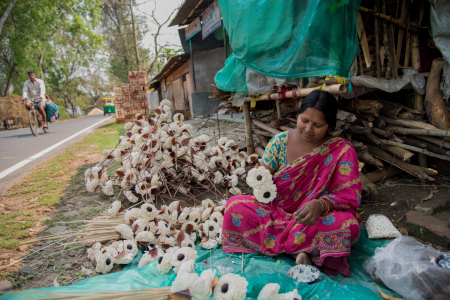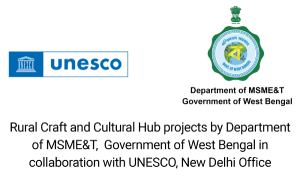 Shola pith (Indian cork) is a delicate, ivory-coloured reed that grows on moist and marshy land in Bengal, Assam, Odisha, Andhra Pradesh and Tamil Nadu. The Shola artists, known as Malakars, do some exquisite, intricate work by cutting and carving the reed to make decorative items of varied kinds, including masks. The Malakars claim their descent from Vishwakarma, the Hindu god of craftsmanship and manufacturing. In the early 20th century, before the first Partition of Bengal in 1905, a group of Shola craftsmen from Chittagong (now in Bangladesh) migrated to Bankapasi of Bardhaman district with their families and started making ornaments and other decorative items from Shola pith. Their main market at the time was the clay idol-makers’ cluster in Kolkata’s Kumartuli. It was from here that Shola craft started gaining popularity and gradually paved the way for large-scale use of Shola, including the widely popular Daker Saaj for the idols of Hindu gods and goddesses, across Bengal and beyond. In the past, decorative Shola pieces were pasted on silk but now the base material has changed to paper. Shola, by nature, is light in weight, organic and fragile and look much like items carved out of ivory. The topor and mukut used in traditional Bengali weddings, and faces of gods and goddesses made from the reed are some of the best examples of Shola craft works’ usage in the society. Shola was not part of earlier RCCH project. In the RCCH Phase II, shola work of different regions of North Bengal and South Bengal have been included. The prominent hubs are Atghara of Dinajpur, Bhatibari in Alipurduar, Bonkapashi of Purba Bardhaman, Surul of Birbhum, Khagra and surrounidng of Murshidabad and Mathurapur of South 24 Parganas. A total of 484 artists have been included in the RCCH II project.
Shola pith (Indian cork) is a delicate, ivory-coloured reed that grows on moist and marshy land in Bengal, Assam, Odisha, Andhra Pradesh and Tamil Nadu. The Shola artists, known as Malakars, do some exquisite, intricate work by cutting and carving the reed to make decorative items of varied kinds, including masks. The Malakars claim their descent from Vishwakarma, the Hindu god of craftsmanship and manufacturing. In the early 20th century, before the first Partition of Bengal in 1905, a group of Shola craftsmen from Chittagong (now in Bangladesh) migrated to Bankapasi of Bardhaman district with their families and started making ornaments and other decorative items from Shola pith. Their main market at the time was the clay idol-makers’ cluster in Kolkata’s Kumartuli. It was from here that Shola craft started gaining popularity and gradually paved the way for large-scale use of Shola, including the widely popular Daker Saaj for the idols of Hindu gods and goddesses, across Bengal and beyond. In the past, decorative Shola pieces were pasted on silk but now the base material has changed to paper. Shola, by nature, is light in weight, organic and fragile and look much like items carved out of ivory. The topor and mukut used in traditional Bengali weddings, and faces of gods and goddesses made from the reed are some of the best examples of Shola craft works’ usage in the society. Shola was not part of earlier RCCH project. In the RCCH Phase II, shola work of different regions of North Bengal and South Bengal have been included. The prominent hubs are Atghara of Dinajpur, Bhatibari in Alipurduar, Bonkapashi of Purba Bardhaman, Surul of Birbhum, Khagra and surrounidng of Murshidabad and Mathurapur of South 24 Parganas. A total of 484 artists have been included in the RCCH II project.



